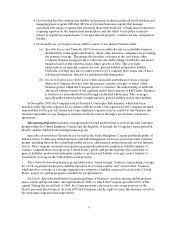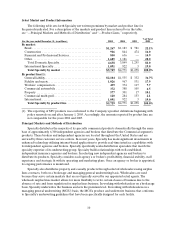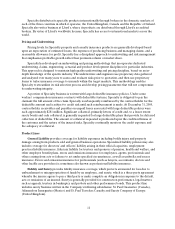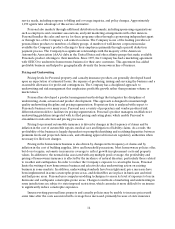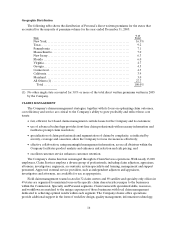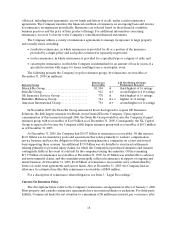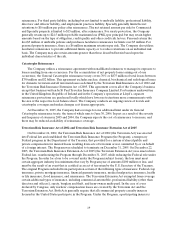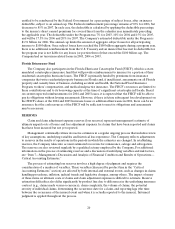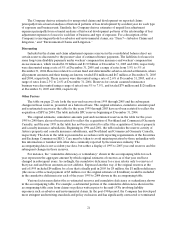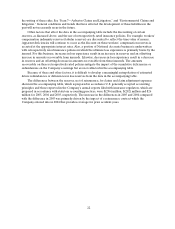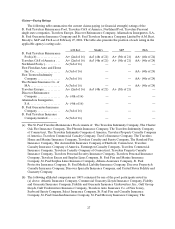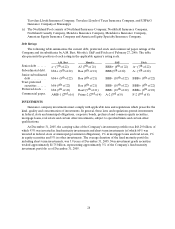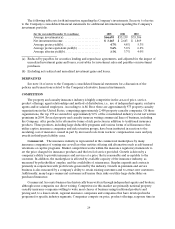Travelers 2005 Annual Report Download - page 31
Download and view the complete annual report
Please find page 31 of the 2005 Travelers annual report below. You can navigate through the pages in the report by either clicking on the pages listed below, or by using the keyword search tool below to find specific information within the annual report.19
reinsurance. For third party liability, including but not limited to umbrella liability, professional liability,
directors’ and officers’ liability, and employment practices liability, Specialty generally limits the net
retentions to $16million per policy after reinsurance. The net retained amount per risk for Commercial
and Specialty property is limited to $15 million, after reinsurance. For surety protection, the Company
generally retains up to $24.5 million probable maximum loss (PML) per principal but may retain higher
amounts based on the type of obligation, credit quality and other credit risk factors. Personal retains the
first $5 million of umbrella policies and purchases facultative reinsurance for limits over $5million. For
personal property insurance, there is a $6 million maximum retention per risk. The Company also utilizes
facultative reinsurance to provide additional limits capacity or to reduce retentions on an individual risk
basis. The Company may also retain amounts greater than those described herein based upon the
individual characteristics of the risk.
Catastrophe Reinsurance
The Company utilizes a reinsurance agreement withnonaffiliated reinsurers to manage its exposure to
losses resulting from one occurrence. For the accumulation of net property losses arising out of one
occurrence, the General Catastrophe reinsurance treaty covers 70% or $875 million of total losses between
$750 million and $2 billion. This agreement excludes nuclear, chemical, biochemical and radiological losses
for domestic terrorism and all terrorism losses as defined by the Terrorism Risk Insurance Act of 2002 and
the Terrorism Risk Insurance Extension Act of 2005. This agreement covers all of the Company’s business
except that business written by St Paul Travelers Insurance Company Limited. For business underwritten
in the United Kingdom, Republic of Ireland and in the Company’s operations at Lloyd’s, separate
reinsurance protections are purchased locally which have lower net retentions more commensurate with
the size of the respective local balance sheet. The Company conducts an ongoing review of its risk and
catastrophe coverages and makes changes as it deems appropriate.
At December 31, 2005, the Company had coverage for one additional limit under its General
Catastrophe reinsurance treaty, the term of which runs to June30, 2006. In part as a result of the severity
and frequency of storms in 2005 and 2004, the Company expects the cost of reinsurance to increase, and
there may be reduced availability of reinsurance coverage.
Terrorism Risk Insurance Act of 2002 and Terrorism Risk Insurance Extension Act of 2005
On November 26, 2002, the Terrorism Risk Insurance Act of 2002 (the Terrorism Act) was enacted
into Federal law and established the Terrorism Risk Insurance Program (the Program), a temporary
Federal program in the Department of the Treasury, that provided fora system of shared public and
private compensation for insured losses resulting from acts of terrorism or war committed by or on behalf
of a foreign interest. The Program was scheduled to terminate on December 31, 2005. On December 22,
2005, the Terrorism Risk Insurance Extension Act of 2005 (theTerrorism Extension Act) was enacted into
Federal law, reauthorizing the Program through December 31, 2007, while reducing the Federal role under
the Program. In order for a loss to be covered under the Program (subject losses), the loss must meet
certain aggregate industry loss minimums that vary by Program year of amounts $100 million or less, and
must be the result of an event that is certified as an act of terrorism by the U.S. Secretary of the Treasury.
The original Program excluded from participation certain of the following types of insurance: Federal crop
insurance, private mortgage insurance, financial guaranty insurance, medical malpractice insurance, health
or life insurance, flood insurance, and reinsurance. The Terrorism Extension Act exempted from coverage
certain additional types of insurance, including commercial automobile, professional liability (other than
directors and officers’), surety, burglary and theft, and farm-owners multi-peril. In the case of a war
declared by Congress, only workers’ compensation losses are covered by the Terrorism Act and the
Terrorism Extension Act. Both Acts generally require that all commercial property casualty insurers
licensed in the United States participate in the Program.Under the Program, a participating insurer is


